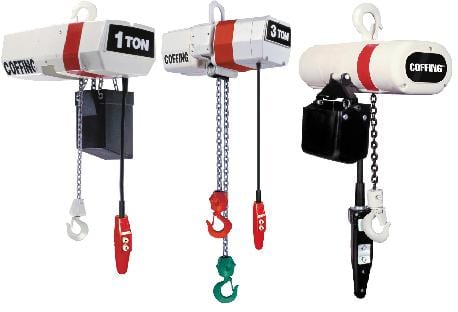Electric Chain Hoist
Electric Hoist Basics
- An electric overhead hoist is often specified when the application calls for more frequent and faster lifting, such as on a factory production line.
- An electric hoist with a motorized trolley is ideal for repetitive lifts which are required to travel long distances.
- A wide range of capacities and speeds are available for both hoists and motorized trolleys.
Electric Hoist Design
- Mechanically, an electric hoist is very similar in design to a hand hoist
- To put it simply, physical operator input (force applied to hand chain or lever) is replaced by an electric motor and controls
- The controls are needed to start and stop the hoist motor and reverse its direction
- A push button pendant station is normally used to control the hoist and/or trolley motions
- Electric powered hoists are available in hook, lug or trolley (push type, hand geared or motorized) suspensions
Electric Hoist Lifting
- Electric chain hoists lifting medium can be either chain (coil or roller type) or wire rope
- Wire rope hoists are generally used for higher capacities, faster speeds, smoother and higher lifts
- Chain hoists with the same capabilities as wire rope hoists have become increasingly popular in recent years
- Coil and roller chain hoists are the most popular in the 3 ton and smaller sizes because these hoists are generally smaller in size, lighter and less expensive to manufacture
- All chain hoists provide true vertical lift (load does not vary from the hoist centerline during hoisting or lowering)
- Specially constructed wire rope units can also be furnished to provide true vertical lift when required.
Electric Chain Hoists Duty Cycle
- Duty cycle is one of the most important considerations when choosing an electric hoist for a particular application
- Duty cycle can be most easily defined as “a specified number of operations at stated intervals”
- For an electric hoist, duty cycle is how much work the hoist must perform in a given period
- The weight of the load, lifting distance and frequency of operation, all play an important role in determining the duty cycle capability of an electric hoist.
- The Hoist Manufacturer’s Institute has classified duty cycle requirements by hoist class – either class H1, H2, H3, H4 or H5
- Most hoist manufacturer’s classify their hoists by this criteria and catalog this information for customer use
- Generally speaking, all industrial grade electric hoists available on the US market today meet at least H3 duty cycle as a minimum requirement
- Most electric hoist manufacturers offer overload protection devices for their electric powered hoists, either as standard equipment, or as an added cost option. Some use internal friction type clutches, while others use electrical shut-off devices, or low torque hoist motors.
Hoist Duty Service Classification
|
Hoist Class |
Service Classification |
Typical Areas of Application |
|
H1 |
Infrequent |
Powerhouses |
|
H2 |
Light |
Light machine shop, |
|
H3 |
Standard |
General |
|
H4 |
Heavy |
High volume |
|
H5 |
Severe |
Bulk |
Power Supply Voltage
- Electric hoists are available in several different power supply voltages
- Common AC power supplies used in the USA are: 115-1-60 and 230-1-60 (single phase, 60 hertz household voltages)
- 208-3-60, 230-3-60, 460-3-60 and 575-3-60 (3 phase, 60 hertz industrial voltages)
- Single phase hoists are available for certain models dependent on motor horsepower and hoist capacity
- Three phase hoists are usually available in all capacities
- If required, special motor voltages can usually be furnished at a small extra charge
- Voltage information can usually be found in the manufacturer’s sales specifications.
Typical Uses for Overhead Electric Chain Hoist
Electric hoists are commonly found in industrial plants for the raising, lowering, and transporting material throughout the facility and positioning components in process or assembly operations
- Some more specific uses / markets include:
- Shipping, receiving, and warehousing
- Automotive industry
- Fabricating shops / machine shops
- Foundries and steel mills
- Metal plating
- Lumber mills
- Food handling / pharmaceutical
- Textiles
- Chemical plants
- Manufactured housing industry
More Information
Selecting a Hoist
Hand Chain Hoist & Chain Falls
Lever Hoist
Air Chain Hoist
Wire Rope Hoist
Intelligent Lifting Devices
Selecting a Hoist Trolley
Beaton Industrial is located in Utica, NY and has been a leading supplier of Electric Chain Hoists and Hoist parts in the Northeast since 1989. Our national sales team supplies Chain Hoists and parts nationwide.
If your company is located within the local area including the cities of, Utica, Albany, Syracuse, Binghamton, Watertown, Poughkeepsie or Plattsburgh, New York, be sure to ask a Beaton representative about our hoist installation and maintenance services.
Some of information presented within this webpage was derived from “Hoist Basics” copyright 2001 by Coffing Hoists. [/fusion_builder_column][/fusion_builder_row][/fusion_builder_container]


![CoffingECHookSuspensionModel_HR[1]](https://www.beatonindustrial.com/wp-content/uploads/2011/09/CoffingECHookSuspensionModel_HR1-559x1024.jpg)